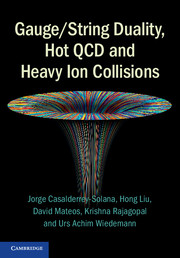Book contents
- Frontmatter
- Contents
- 1 Opening remarks
- 2 A heavy ion phenomenology primer
- 3 Results from lattice QCD at nonzero temperature
- 4 Introducing the gauge/string duality
- 5 A duality toolbox
- 6 Bulk properties of strongly coupled plasma
- 7 From hydrodynamics to far-from-equilibrium dynamics
- 8 Probing strongly coupled plasma
- 9 Quarkonium mesons in strongly coupled plasma
- 10 Concluding remarks and outlook
- Appendix A Green–Kubo formula for transport coefficients
- Appendix B Hawking temperature of a general black brane metric
- Appendix C Holographic renormalization, one-point functions, and a two-point function
- Appendix D Computation of the holographic stress tensor
- References
- Index
3 - Results from lattice QCD at nonzero temperature
Published online by Cambridge University Press: 05 July 2014
- Frontmatter
- Contents
- 1 Opening remarks
- 2 A heavy ion phenomenology primer
- 3 Results from lattice QCD at nonzero temperature
- 4 Introducing the gauge/string duality
- 5 A duality toolbox
- 6 Bulk properties of strongly coupled plasma
- 7 From hydrodynamics to far-from-equilibrium dynamics
- 8 Probing strongly coupled plasma
- 9 Quarkonium mesons in strongly coupled plasma
- 10 Concluding remarks and outlook
- Appendix A Green–Kubo formula for transport coefficients
- Appendix B Hawking temperature of a general black brane metric
- Appendix C Holographic renormalization, one-point functions, and a two-point function
- Appendix D Computation of the holographic stress tensor
- References
- Index
Summary
At very high temperature, where the QCD coupling constant g(T) is perturbatively small, hard thermal loop resummed perturbation theory provides a quantitatively controlled approach to QCD thermodynamics. However, in a wide temperature range around the QCD phase transition which encompasses the experimentally accessible regime, perturbative techniques become unreliable. Nonperturbative lattice-regularized calculations provide the only known, quantitatively reliable, technique for the determination of thermodynamic properties of QCD matter within this regime.
We shall not review the techniques by which lattice-regularized calculations are implemented. We merely recall that the starting point of lattice-regularized calculations at nonzero temperature is the imaginary time formalism, which allows one to write the QCD partition function in Euclidean spacetime with a periodic imaginary time direction of length 1/T [541]. Any thermodynamic quantity can be obtained via suitable differentiation of the partition function. At zero baryon chemical potential, the QCD partition function is given by the exponent of a real action, integrated over all field configurations in the Euclidean spacetime. Since the action is real, the QCD partition function can then be evaluated using standard Monte Carlo techniques, which require the discretization of the field configurations and the evaluation of the action on a finite lattice of spacetime points.
- Type
- Chapter
- Information
- Gauge/String Duality, Hot QCD and Heavy Ion Collisions , pp. 65 - 91Publisher: Cambridge University PressPrint publication year: 2014

